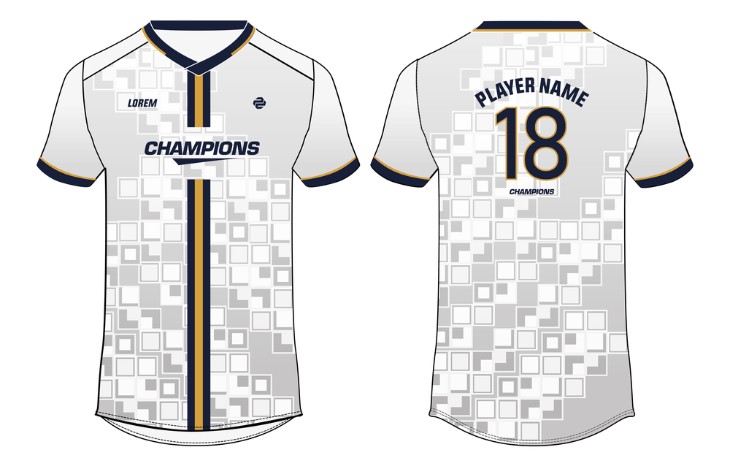Introduction
The numbers on the back of England cricket shirts hold significant historical and organisational importance within the sport. These numbers serve as identifiers for each player, allowing fans, commentators, and officials to easily recognise and track individual team members during matches. However, the story behind these numbers goes beyond mere identification; it encapsulates a rich tapestry of tradition, milestones, and personal achievements that have shaped the legacy of English cricket. In this article, we will delve into the fascinating history of the numbers on the back of England cricket shirts, exploring their evolution, notable players associated with specific numbers, and the unique anecdotes that make these numerical insignias an integral part of cricketing lore.
Why do players have numbers on their backs?
Players have numbers on their backs for several practical and symbolic reasons:
1. Identification: In a fast-paced game like cricket, especially in formats like One Day Internationals (ODIs) and T20 matches, quick identification of players is crucial for fans, commentators, and officials. The numbers provide a convenient way to recognise individual players amidst the action.
2. Team Unity: Uniform numbers contribute to a sense of unity and cohesion within the team. It helps create a visual bond among players and reinforces the collective identity of the team.
3. Statistical Reference: Assigning numbers makes it easier for statisticians and analysts to keep track of player performance. This is especially important for recording runs scored, wickets taken, and other statistical data during a match.
4. Legacy and Tradition: The practice of wearing numbers has become a tradition in cricket. It allows fans to associate specific numbers with legendary players and their achievements, creating a sense of continuity across generations.
5. Marketing and Merchandising: Player numbers have commercial value. Fans often buy merchandise like jerseys with their favourite player's number, which helps in marketing and generating revenue for both the team and the sport.
6. Respect for Seniority: In some cases, players with more experience or seniority in the team may be given lower numbers as a mark of respect for their contributions and experience.
7. Historical Significance: Certain numbers might be retired or reserved for players who have made extraordinary contributions to the sport or the team. This adds a layer of historical significance to the numbers.
When did cricketers start wearing numbers on their shirts?
Cricketers began adorning numbers on their shirts during the latter half of the 20th century. This practice gained traction in the 1960s, with English county cricket being one of the earliest adopters. The innovation was introduced to facilitate the identification of players on the field, especially in the one-day format, where the pace of the game demanded swift recognition.
The inaugural instance of numbers being worn on international cricket shirts occurred during the 1975 Cricket World Cup. England, Australia, and New Zealand were the pioneering teams to display these numerical insignias on their attire. This marked a watershed moment in the evolution of cricket attire, introducing a visual identifier that would become an integral part of the sport's tradition.
Since then, the practice of wearing numbers has become commonplace in international cricket, extending to various formats and competitions worldwide. The numbers have come to symbolise individual players and their respective roles within the team, while also serving practical purposes for players, officials, and avid cricket enthusiasts alike.

Numbering System in England Cricket
In England cricket, the numbering system is a method used to identify individual players during matches. It is a tradition deeply embedded in the game's culture. Each player is assigned a unique number that corresponds to their position on the team. This number is prominently displayed on the back of their cricket shirt.
The rationale behind this practice is twofold. Firstly, it aids spectators, commentators, and officials in swiftly recognising and distinguishing players in the midst of the match's fast-paced action. This is particularly important in formats like One Day Internationals (ODIs) and Twenty20 matches, where the tempo can be quite brisk.
Secondly, the allocation of numbers holds historical and sentimental significance. Certain numbers may be associated with legendary players who have left an indelible mark on the sport. These numbers serve as a tribute to their contributions and act as a link between past and present generations of cricketers.
Furthermore, this numbering system fosters a sense of unity within the team. It promotes a collective identity, reinforcing the idea that each player is a vital part of the larger whole.
In addition, the numbers serve a practical function for statisticians and analysts. They provide an organised means of recording and cataloguing individual player statistics, such as runs scored, wickets taken, and other performance metrics.
In essence, the practice of assigning numbers in England cricket is a blend of practicality, tradition, and respect for the rich history of the sport. It encapsulates the essence of cricket as a team sport while honouring the individual contributions of players.
When Did Cricketers Start Wearing Numbers in Test Matches?
Cricketers began wearing numbers on their shirts during Test matches in the 1990s. This practice was introduced to aid spectators, commentators, and officials in identifying individual players more easily amidst the fast-paced and competitive nature of international cricket.
Before this development, players in test matches were not assigned numbers on their shirts. Instead, they were recognised by their names and positions. However, as the popularity of cricket grew and matches became more televised, the need for a visual identifier became apparent.
The numbering system was initially met with some resistance from traditionalists who believed that it introduced an unnecessary modern element to the game. However, over time, it proved to be a practical addition that improved the overall viewing experience for cricket enthusiasts.
How are jersey numbers assigned in cricket?
In cricket, the assignment of jersey numbers is typically determined by a combination of factors, including player preference, seniority, and team management decisions.
1. Player Preference: Players often have the opportunity to express their preference for a particular number. This could be based on personal superstitions, fondness for a specific numeral, or perhaps it holds sentimental value for them.
2. Seniority: In some cases, more experienced or senior players on the team may have a say in choosing their preferred number. This is a mark of respect for their contributions and leadership within the squad.
3. Managerial Decision: Ultimately, the final decision often rests with the team management, including the coach and captain. They may consider factors such as team dynamics, player preferences, and any historical significance attached to certain numbers.
Fan Engagement and Shirt Numbers
Fan engagement and shirt numbers in England cricket are intimately linked, creating a unique bond between players and supporters. Here's how fan engagement is intertwined with shirt numbers:
1. Personal Connection: Shirt numbers allow fans to develop a personal connection with their favourite players. Supporters often associate specific numbers with particular athletes who have made an impact on the team or the sport.
2. Merchandise and Branding: Fans frequently purchase jerseys with their preferred player's number, which serves as a form of expression and support. This not only generates revenue for the team but also reinforces the player's brand and popularity.

3. Social Media and Interaction: Players often use their shirt numbers as part of their personal brand on social media platforms. This can include usernames, hashtags, or other ways of incorporating their number, enabling them to interact directly with fans.
4. Recognition and Acknowledgment: When fans see a player donning their chosen number on the field, it serves as a visual acknowledgment of their support. This recognition can be a powerful motivator for fans to continue backing their favourite players.
5. Fan Initiatives and Contests: Teams may run initiatives or contests related to shirt numbers, allowing fans to engage directly with the players. This could involve opportunities to meet players, receive signed merchandise, or even have a say in jersey design.
6. Historical Significance: Certain numbers may hold special meaning in a team's history, associated with iconic players or moments. Recognising and celebrating these historical connections can deepen fan engagement and foster a sense of tradition.
7. Fan Forums and Communities: Fan communities often form around specific players and their shirt numbers. These communities provide a platform for fans to discuss, share, and celebrate their favourite players' performances and achievements.
8. Player-Fan Interaction: Players may acknowledge or interact with fans who have their number on a jersey during matches. This direct engagement can be a memorable experience for supporters and further solidify their connection with the player.
9. Player-Driven Initiatives: Some players actively engage with fans through initiatives related to their shirt numbers. This could involve charity work, fan meet-ups, or other events that provide opportunities for supporters to interact with the player. In essence, shirt numbers serve as a tangible and symbolic link between players and fans in England cricket.
Bottom Line:
The numbers adorning the back of England cricket shirts are far more than mere identifiers; they encapsulate a rich tapestry of tradition, unity, and individual legacy within the sport. These numerical insignias serve as a practical means of distinguishing players in the heat of the match, enhancing the viewing experience for fans, and aiding officials. Moreover, they evoke a sense of unity and belonging among team members, reinforcing the collective identity of the squad.
Beyond their functional purpose, these numbers hold profound historical and sentimental significance. They pay tribute to iconic players who have left an indelible mark on the sport, creating a bridge between generations of cricketers. Each number tells a story, bearing witness to moments of triumph and individual brilliance.
For more information:
- What is a No-ball in Cricket
- What is Powerplay In Cricket?
- What is an Over In Cricket?
- What is Strike Rate in Cricket?


